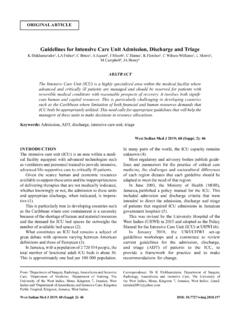Transcription of Care in Canadian ICUs
1 care in Canadian ICUsAugust 2016 Production of this document is made possible by financial contributions from Health Canada and provincial and territorial governments. The views expressed herein do not necessarily represent the views of Health Canada or any provincial or territorial rights contents of this publication may be reproduced unaltered, in whole or in part and by any means, solely for non-commercial purposes, provided that the Canadian Institute for Health Information is properly and fully acknowledged as the copyright owner. Any reproduction or use of this publication or its contents for any commercial purpose requires the prior written authorization of the Canadian Institute for Health Information. Reproduction or use that suggests endorsement by, or affiliation with, the Canadian Institute for Health Information is permission or information, please contact CIHI: Canadian Institute for Health Information495 Richmond Road, Suite 600 Ottawa, Ontario K2A 4H6 Phone: 613-241-7860 Fax: 978-1-77109-476-4 (PDF) 2016 Canadian Institute for Health InformationHow to cite this document: Canadian Institute for Health Information.
2 care in Canadian ICUs. Ottawa, ON: CIHI; publication est aussi disponible en fran ais sous le titre Les unit s de soins intensifs au 978-1-77109-477-1 (PDF)Table of contents Executive summary .. 4 Acknowledgements .. 5 Introduction .. 7 System implications .. 8 Use of ICUs in Canada .. 9 ICU capacity and challenges ..10 Trends and ICU admissions ..13 Admission to the ICU ..15 ICU at end of life ..16 ICU patient populations and process of care ..17 Types of patients most commonly seen in ICUs ..17 ICU processes of care ..21 Use of invasive ventilation ..23 Costs ..26 Conclusion ..27 Appendix A: Data sources, case selection and study limitations ..29 Appendix B: Text alternative for figures ..31 References ..33 care in Canadian ICUs 4 Executive summary The intensive care unit (ICU) provides critical care to severely ill patients.
3 In 2013 2014, 11% of adult hospital stays in Canada outside of Quebec included time in an ICU. Experts have suggested that an increase in the severity of illness among hospital patients, coupled with Canada s aging population, may contribute to an expected rise in the use of and, in turn, the cost of ICUs in the coming , 2 The average daily cost of an ICU stay is estimated to be as high as 3 times the average cost of a day s stay on a general ward, as ICU stays are more resource- intensive from personnel to equipment and medication. For these reasons, it is important to better understand the use of this constrained resource with respect to operating patterns, patient flow, trends in admissions, patient populations and process of care for those treated in ICU. Using mainly administrative data from the Canadian Institute for Health Information (CIHI), this study examines care in ICUs across Canada, excluding Quebec.
4 The study s main findings are as follows: 1. The use of ICUs in Canada is increasing faster than acute care hospitalizations overall. In 2013 2014, there were more than 230,800 adult ICU admissions in Canada, an increase of 12% since 2007 2008. During the same time frame, adult hospital admissions increased by 7%. 2. 8 in 10 ICU admissions resulted from urgent hospital admissions. This has implications for patient outcomes, resource utilization and capacity planning. 3. Most ICU beds are in large or teaching facilities, where having enough ICU beds to meet the growing demand is a widespread challenge. On average, large and teaching hospital ICUs operate at about 90% capacity, with periods of overcapacity equivalent to between 45 and 51 days in 2013 2014. 4. A growing number of ICU patients need specialized, resource- intensive care .
5 Invasive ventilation is one of the most common processes of care in ICU, received by 33% of ICU patients in 2013 2014, up from 28% in 2007 2008. The biggest increase was among those who received short-term ( , less than 96 hours) invasive ventilation. The continued rise in use for ventilation could place additional strain on ICUs. ICU capacity is a current and future health system challenge in Canada. The aging population and concerns around the potential increase in severity of illness among hospital patients could place additional demands on Canadian ICUs in the coming decades. This report and its companion products can help inform evidence-based system improvement efforts by providing a baseline of comparable measures of ICU care in Canada. It can also serve as a resource for discussions about advance care planning and goals of care , as well as care plans for the prevention and treatment of chronic conditions.
6 care in Canadian ICUs 5 Acknowledgements The Canadian Institute for Health Information (CIHI) wishes to acknowledge and thank the many individuals and organizations whose work contributed to the development of this report. Thank you to the following expert advisors for their review of relevant materials: Dr. Sean Bagshaw Associate Professor, University of Alberta Dr. Peter Dodek Professor of Medicine, University of British Columbia Dr. Rob Fowler Senior Scientist, Sunnybrook Health Sciences Centre Dr. Allan Garland Professor of Medicine and Community Health Sciences, University of Manitoba Dr. Claudio Martin Professor, Department of Medicine, Schulich School of Medicine and Dentistry, Western University Chair/Chief Critical care , London Health Sciences Centre Dr. Damon Scales Scientist, Sunnybrook Health Sciences Centre Dr.
7 Susan Shaw Assistant Professor, University of Saskatchewan Dr. Hannah Wunsch Senior Scientist, Sunnybrook Health Sciences Centre Thank you also to the Canadian Critical care Trials Group (CCCTG) and Canadian Critical care Society (CCCS), both of which contributed to the development of this report and companion products through expert engagement and collaboration on communications with community. It should be noted that the analyses and conclusions in this report do not necessarily reflect the opinions of the affiliated individuals and organizations. care in Canadian ICUs 6 care in Canadian ICUs represents a collaborative effort across much of CIHI. We would like to thank all those who contributed their expertise and time in various capacities: conducting research, literature reviews and environmental scans; compiling, analyzing and validating the data; writing and editing; and reviewing content and providing generous and ongoing support to the core team.
8 This report had the guidance, support and leadership of Kathleen Morris, Vice President, Research and Analysis Tracy Johnson, Director, Health System Analysis and Emerging Issues Cheryl Gula, Manager, Health Reports The core project team for this report included Allie Chen, Senior Analyst, Health Reports Clare Cheng, Senior Analyst, Health Reports Catherine Chan, Analyst, Health Reports Josh Fagbemi, Program Lead, Health Reports David Lam, Senior Coordinator, Health Reports Michelle Parker, Program Lead, Health Reports The team is grateful for the generous support and assistance from many areas across CIHI. In particular, we d like to thank those in Integrated Client Support and Clinical Administrative Databases. As well, we are appreciative of the contributions of other CIHI staff members for their work on translation, communications, web design, print and distribution.
9 care in Canadian ICUs 7 Introduction The intensive care unit (ICU) is a vital component of acute care in Canada. It is where critically ill patients receive life-supporting care . ICUs are resource- intensive from personnel to equipment and medication and therefore costly. ICUs serve a broad range of patients, from those with pre-existing conditions to those with unexpected injuries or illness, as well as those who need support before and after undergoing complex procedures. In 2013 2014, 11% of the more than 2 million adult hospital stays in Canada (outside of Quebec) included time in an ICU. Experts have suggested that an increase in severity of illness among hospital patients, coupled with Canada s aging population, may contribute to an expected rise in use and, in turn, cost of ICUs in the coming , 3 Such concerns underscore the increasing importance of understanding the use of ICUs, and the quality of care and outcomes for patients treated in ICU.
10 There are different types of ICUs that provide care to specific patient populations. Canadian ICUs can be broadly categorized into 3 types: general, specialized, and pediatric and neonatal. General ICUs provide care to patients who require intensive care for common medical and surgical reasons. Specialized ICUs ( , burn, cardiac, neurosurgery, trauma, respirology) provide care to meet the needs of a specific type of illness or injury. Pediatric and neonatal ICUs provide intensive care to children and newborns. Other types of special care units include step-down units (SDUs), which are also typically classified as medical, surgical or combined. These units provide a higher level of care for hospital patients than can be provided in a general inpatient unit . ICUs use different approaches to organize and manage care needs.






